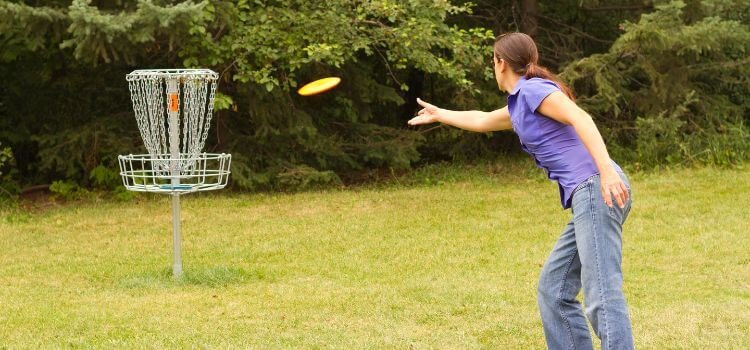As an Amazon Associate I earn from qualifying purchases.
When it comes to disc golf, one of the most important factors to consider is the disc’s stability. A disc’s stability can significantly impact its flight pattern, making it crucial for players to understand the differences between stable vs unstable golf disc. In this comprehensive comparison, we will explore the characteristics of both stable and unstable discs, exploring their advantages and disadvantages and helping you decide which type of disc is best suited for your game. Join us as we explore the fascinating world of stable vs unstable disc golf discs.

The Importance of Disc Stability
Disc stability is crucial in disc golf as it determines the disc’s flight path.
Understanding the concept of disc stability
Disc stability refers to the disc’s tendency to resist turning during flight. This quality is determined by various factors of the disc’s design, such as its shape, weight distribution, and rim configuration. Understanding disc stability is crucial for players as it allows them to choose discs that align with their throwing style and desired flight characteristics.
Outside factors like wind speed and technique can also have a notable impact on a disc’s stability during a throw. By considering all these elements, players can make informed decisions when selecting a disc for their game.
How stability affects flight characteristics
Stability significantly affects the disc’s flight path, making it the foundation of shot selection in disc golf. With a stable disc, players can expect a more consistent and predictable flight, allowing them better to gauge the distance and accuracy of their throw. These discs will fly straight for longer distances before gently fading at the end, providing players with a reliable option for those long-distance shots.
On the other hand, understable discs offer a unique flight pattern as they tend to turn to the right for right-handed throwers. This can be advantageous in certain situations, such as when players must navigate obstacles or execute a specific shot shape.
On the opposite end, overstable discs fade left after the initial throw. This characteristic makes them ideal for shots that require a solid hook to the left, such as when players need to navigate around trees or other obstacles.
Understanding how stability influences flight characteristics helps players maximize their distance and accuracy on the course. By choosing the right disc for each shot, players can enhance their performance and control the disc’s flight better.
The significance of stability for different skill levels
Disc stability is crucial for both beginners and experienced players, albeit for different reasons. Stable discs offer consistency and forgiving flights for beginners, making it easier to learn and control their throws. These discs provide a predictable flight path, allowing beginners to focus on their technique and build confidence in their throws.
On the other hand, advanced players rely on stable discs for specific shots that require precise control and distance. These players have the skill to manipulate the flight characteristics of a stable disc to execute various shot shapes and navigate around obstacles.
Stability preferences may also differ based on throwing power and technique, highlighting the importance of different skill levels to understand the various stability ratings. Players can optimize their performance on the course by selecting the appropriate stability for their skill level.
Characteristics of Stable vs Unstable Disc Golf
Here’s a comparison of the characteristics of stable and unstable (understandable) discs in the context of disc golf:
Characteristics of Stable Disc
Here are the characteristics of a stable disc, particularly in the context of disc golf:

Defining stable disc
Stable discs have a neutral stability rating, falling between understable and overstable discs. Unlike understandable discs that tend to turn to the suitable or overstable discs that fade left, stable discs maintain a consistent flight pattern throughout the throw, resisting excessive turning or fading.
This inherent stability makes them a reliable player, especially in challenging weather conditions like strong crosswinds. Stable discs are often preferred for playing in windy conditions as they are less affected by unpredictable gusts, allowing players to have better control over their throws.
Moreover, these discs balance distance and control, making them suitable for players of all talent levels. Whether beginners or experienced players, everyone can benefit from the consistent flight and forgiving nature of stable discs, enhancing their overall performance on the course.
Traits and flight patterns of stable disc
Stable discs typically have a straight flight path with a slight gradual fade at the end. This flight characteristic makes them predictable and easier to control, particularly for players still developing their throwing technique.
Stable discs require less power and arm speed than understandable discs, allowing players to maintain better control over their throws. Some stable discs also feature a flat top, providing a comfortable grip and ensuring a consistent release.
These discs are renowned for their reliable and consistent performance, delivering accurate shots regardless of their throwing style or technique.
Advantages and disadvantages of stable disc
One advantage of stable discs is that they offer more control and accuracy, allowing players to hit specific lines and targets with confidence. With their consistent flight path and minimal turning, stable discs are less prone to flipping over or turning excessively, ensuring a more consistent flight.
However, it is essential to note that stable discs may sacrifice some distance potential compared to more overstable discs. Players looking for maximum distance or those with higher arm speeds may find stable discs limiting in achieving maximum distance potential.
Finding the right balance between control and distance is essential when choosing stable discs for your game.
Characteristics of Unstable Disc
Unstable discs are a different story altogether. Here are the characteristics of unstable (understandable) discs, particularly in the context of disc golf:

Defining unstable disc
Unstable discs typically have a lower stability rating, allowing them to turn more easily. This means that their flight paths are more variable compared to stable discs. While unstable discs are designed to provide maximum distance, they may sacrifice accuracy and control.
These discs require more skill and technique to manipulate for desired flight paths, making them a preferred choice for experienced players who can effectively harness their potential.
Traits and flight patterns of unstable disc
Unstable discs distinguish themselves from their stable counterparts through their unique flight characteristics. One prominent trait of unstable discs is their tendency to demonstrate a greater degree of high-speed turn at the start of their flight. This means that when released, these discs can quickly veer off their intended path, making them more challenging to control.
Additionally, unstable discs often exhibit a significant amount of lateral movement during the early stages of their flight, further adding to their unpredictable nature. As a result, their flight paths may develop into unexpected S-curves or even roller shots.
Furthermore, due to their inherent instability, unstable discs are more susceptible to the influence of wind conditions. While this can be beneficial in specific scenarios, it also means that players need to be mindful of the wind’s impact on their shots when using these discs.
Advantages and disadvantages of unstable disc
Unstable discs appeal to players who crave maximum distance potential on the disc golf course. These discs are known for achieving longer distances, making them ideal for open courses where distance is a priority.
They are particularly suitable for players who prefer a more aggressive and risk-taking playing style, as the unpredictable flight patterns of unstable discs can sometimes offer unique shot opportunities.
However, it’s important to note that unstable discs can be more challenging to control and require a higher skill level to master. It takes skill and finesse to navigate their quick turn and aggressive fade, but the rewards can be outstanding for those who can harness their potential.
Choosing the Right golf Disc for Your Game of Stable vs Unstable
Choosing the right disc for your game in the context of stable vs. unstable disc golf involves understanding your throwing style, skill level, and the specific shots you need to execute. Here’s a guide to help you make the best choices:
Factors to consider when selecting a disc
When choosing a disc for your game, there are several factors to consider that can significantly impact its stability and flight characteristics. One crucial factor is the weight of the disc.
Generally, lighter discs have the potential to offer more distance, while heavier discs have better wind resistance. A lighter disc may be the way to go if you want maximum distance.
On the other hand, if you frequently play in windy conditions, a heavier disc can provide more stability and control. Another aspect to consider is the rim width of the disc. A wide rim offers more stability and is ideal for power throwers, allowing for a more controlled release.
On the contrary, a narrow rim is better suited for beginners or players with less power, as it provides an easier grip and release.
Additionally, the type of plastic used in the disc can affect its flight characteristics. Some plastics are more durable and retain stability longer, while others offer more grip for better control.
Lastly, understanding the flight ratings of a disc, which include speed, glide, turn, and fade, can help you select a disc that aligns with your throwing style. Each rating provides valuable information about the disc’s performance and can guide you in choosing the perfect disc for your game.
By considering these factors and experimenting with different discs, you can find the disc that best suits your essentials and helps you maximize your performance on the disc golf course.
Matching disc stability to your throwing style
If you have a slow arm speed or tend to release discs with hyzer angles, a stable disc will be more forgiving and easier to control. These discs fly straight with minimal turn and fade, making them ideal for players who prefer consistent and accurate shots.
On the other hand, players with faster arm speeds or those who release discs with anhyzer angles may prefer an understandable disc for enhanced distance and shot-shaping potential. These discs are designed to turn to the right for right-handed throwers, offering more distance and allowing for a wider variety of shot options.
Additionally, overstable discs are suitable for players who throw with high power and require a disc that resists turning and finishes with a strong fade. These discs are perfect for battling headwinds and performing reliable hyzer shots.
Ultimately, the best way to determine which disc stability is proper for you is to experiment with different stabilities to find the disc that best suits your throwing style. Disc golf is a game of finesse and technique, and finding the perfect stability can significantly enhance your performance on the course.
Finding the proper stability for specific shots or conditions
When throwing into a headwind, an overstable disc will resist turning and “cut” through the wind, allowing for a more accurate and controlled throw. This stability is beneficial in challenging wind conditions where maintaining control over the disc’s flight path is crucial.
On the other hand, for shots that require a strong fade at the end, such as sharp doglegs or spike hyzers, an overstable disc can provide the desired flight path by reliably finishing to the left for right-handed throwers. This predictability is essential in executing precise shots that require a sharp turn at the end.
Additionally, a flippier, understandable disc can navigate tight lines and provide optimal control when faced with narrow fairways or obstacles. Its tendency to turn to the right for right-handed throwers allows for more creativity in shot shaping and maneuvering around obstacles.
Lastly, it is essential to consider the disc’s stability when throwing uphill or downhill, as it can influence the disc’s flight and landing angle. An understandable disc may be more suitable for uphill shots, as it will naturally increase height and distance.
In contrast, an overstable disc can provide better control and accuracy when throwing downhill. Ultimately, understanding how different stability levels can impact your throws in various situations will significantly enhance your overall performance on the disc golf course.
You may also read this article
Disc Golf Forehand vs Backhand
Tips for Adjusting to Different Disc Stabilities
Here are some tips for adjusting to different disc stabilities in the context of disc golf:
Experimenting with different discs
If you’re new to disc golf or looking to improve your game, it’s essential to experiment with discs of different stability levels. Start by trying out discs that are overstable, understandable, and neutral. This will give you a better understanding of how each disc behaves during different parts of its flight.
By exploring discs from various brands and models, you can find the ones that feel comfortable in your hand and best match your throwing style.
Additionally, pay attention to how wind conditions affect the flight of different discs. This understanding will help you make informed choices during actual gameplay. If you want to try a broader range of disc stabilities without committing to buying them, consider borrowing discs from fellow disc golfers or renting them from a local disc golf shop. This lets you experiment with different discs and discover which stability works best.
Adapting your technique for stable and unstable discs
Focusing on generating a strong and consistent throwing motion is crucial for stable discs. You can generate maximum power and control by engaging your body’s core muscles and using proper weight shifts. This will allow you to accurately release the disc at the desired angle and achieve the desired flight path.
On the other hand, for unstable discs, a finesse-based approach is required. Practicing controlled and smooth releases is essential to avoid excessive turns or fades during the flight. By developing a delicate touch, you can manipulate the disc’s flight and make the most of its unstable nature.
When using an overstable disc, it is essential to adjust your release angle. Aim slightly to the opposite side of the desired target line to compensate for the natural fade of the disc. This adjustment will help you achieve the desired flight path and ensure accuracy.
Conversely, with understandable discs, using less power and relying more on finesse is crucial. Focus on a smooth and gradual release to maximize the disc’s potential for distance and turning. By mastering the art of finesse, you can make the most of the disc’s unstable nature and unleash its full potential.
Practicing to improve control and accuracy
To improve your disc golf game and become more proficient with different disc stabilities, there are several strategies you can implement. One effective method is to set up targets at various distances and practice throwing different discs at them.
This will not only help you develop a better understanding of how each disc behaves in terms of distance and accuracy, but it will also allow you to fine-tune your throwing technique. Experimenting with different grip styles, release points, and angles can significantly impact your throws.
Remember, even minor adjustments can significantly affect your overall performance. Another valuable tip is to join local disc golf leagues or find training partners to practice with. By playing with others, you’ll be able to observe different throwing techniques and learn from experienced players.
Lastly, consider incorporating training drills and exercises into your practice routine. There are specific drills designed to improve disc golf throwing technique, such as fieldwork, putting practice, and focusing on specific shots or throwing styles. Dedicating time to these drills can enhance your skills and help you become a well-rounded disc golfer.
FAQs About Stable vs Unstable Disc Golf
Stable discs are generally recommended for beginners. They balance distance potential and control well, helping newcomers learn proper throwing techniques and achieve accuracy.
Use stable discs for straight shots, precision approaches, controlled hyzer shots, and in windy conditions. Their consistent flight path and wind resistance make them suitable for various scenarios.
Unstable discs are best suited for experienced players who can manipulate their flight characteristics. They are great for shot shaping, turnovers, anhyzer shots, rollers, and maximizing distance potential.
Unstable discs can be more challenging to control due to their tendency to turn and follow a curved flight path. They require a higher level of throwing skill and technique to achieve desired results.
Many players carry a mix of stable and unstable discs to address different shots and course conditions. Having a well-rounded selection allows you to adapt to various challenges.
Stable discs handle wind better than unstable discs. Their consistent flight path helps them resist being pushed off course by crosswinds. Unstable discs are more sensitive to wind, especially headwinds, which can exaggerate their turn.
Skilled players can leverage the turn of unstable discs to achieve greater distance. By releasing the disc with the appropriate angle and power, you can use its flight characteristics to your advantage.
Conclusion
Understanding disc stability and its impact on flight is vital for disc golfers. Stable discs offer consistency and control, while unstable ones allow finesse and manipulation. Picking the right disc means considering your style and conditions.
Adjusting to stabilities means experimenting and adapting techniques. Try various brands and models, considering the feel and style. Note wind effects for informed choices. Borrow or rent discs to explore. Adapt technique for optimal flight: power for stable, finesse for unstable.
Practice control by setting targets, adjusting grip, and joining leagues. Drills enhance skills. By grasping stability, trying different discs, and adjusting technique, you’ll boost your game and excel in disc golf. So enjoy, have fun, and strive for mastery with stable vs unstable golf disc.
Amazon and the Amazon logo are trademarks of Amazon.com, Inc, or its affiliates.



Leave a Reply